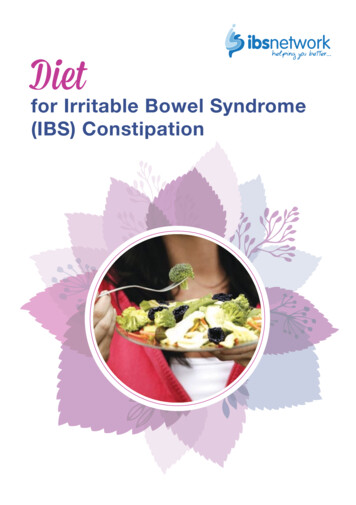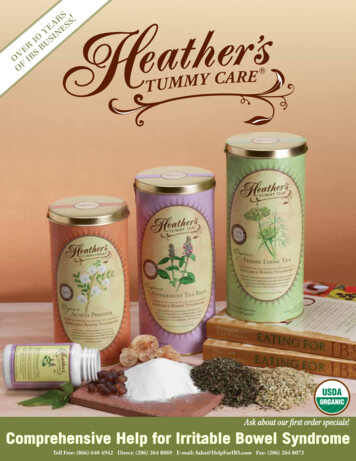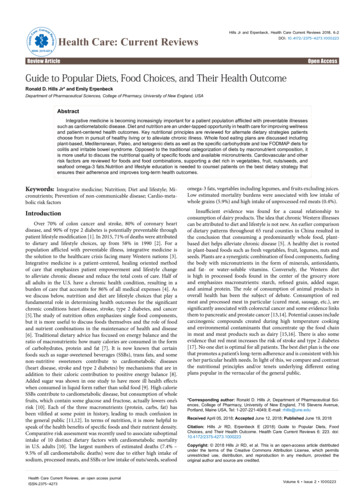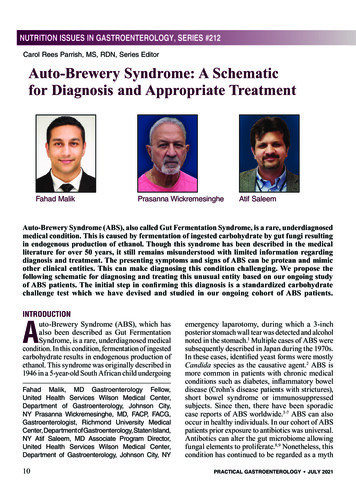
Transcription
Diethelping you better.for Irritable Bowel Syndrome(IBS) Constipation
ContentsWhat is IBS constipation?3Dietary advice for constipation4Dietary Fibre10Exercise11Relaxation12What about probiotics?12Day to day25Fluid13Ideas for breakfast, lunch and dinner13Foods to avoid or limit14Keep in mind15Recipes16Muesli16Chicken and Root Vegetable Stew17Prune Juice Mocktail18Bean Salad19Pizza20Prune Juice and Live Yogurt Smoothie21Spelt Bread22Oatcake23
What isIBS constipation?Irritable Bowel Syndrome is a disorder of gastrointestinal (GI)function without any obvious inflammation or damage. Symptomsoccur quite frequently and are often triggered by changes in dietand the effect of stress and life changes on the way the gut works.Common recurrent symptoms include abdominal pain or discomfort,often reported as cramping, along with changes in bowel habits.IBS has been subcategorised based on the symptoms as: IBS withdiarrhoea; IBS with constipation: or mixed, which includes bothdiarrheal and constipation traits.The definition of IBS with constipation (IBS-C) may include: fewerthan three bowel movements a week, the passage of dry, hardor small stools, the need to strain to pass stools, and a feeling ofincomplete emptying of the bowel. In IBS, constipation is oftenassociated with bloating, abdominal distension, and abdominalpain, and may occasionally alternate with diarrhoea.3
Dietary advicefor constipationThe causes of IBS are not well understood, however dietary andlifestyle changes can help to alleviate symptoms.Eating a healthy diet, with the right balance of foods from the four mainfood groups is a good first step towards reducing symptoms. Thisincludes: Starchy carbohydrates: bread, potatoes, pasta, rice andwholegrains Vegetables, salads and fruit - fresh, frozen, or dried Meat, fish, eggs, nuts, beans & vegetarian protein alternatives Milk, cheese, yoghurtIf you are constipated, it is important to aim for at least 5 portionsof fruit or vegetables a day. This is not only for the associated healthbenefits but also for the fibre contribution to the diet. It is also worthlimiting highly processed foods as these tend to be higher in fat, saltand sugar and often lower in fibre.4
Dietary FibreDietary fibre is predominantlycomposed of all the constituents ofcereals, vegetables and fruits that cannotbe digested in the small intestine. It includesthe storage polysaccharides of tubers and seeds,the cellulose structure of stems and leaves, the pulp and the skins offruits and the husks and hard coats of nuts and seeds. It may alsoencompass resistant starches formed when wheat, potato or rice areallowed to cool and are then reheated causing the starch molecules toclump together and resist digestion.Most dietary fibre, except the hard woody coats or husks of seeds,gets broken down by bacterial action in the colon. This tends to retainmore fluid in the bowel and generates gas, stimulating secretion andperistalsis, encouraging the proliferation of bacteria and adding tothe bulk of colonic contents. Most people do not eat enough fibre.Increasing dietary fibre can therefore help to soften the stools, makingthem easy to pass and relieving symptoms of constipation. As youincrease the fibre in your diet, increase the fluid you drink as fibresoften the stools by retaining water in the gut.Dietary fibre has been somewhat arbitrarily been divided into solubleand insoluble components. Insoluble fibre consists of the skins of fruits,the stalks and leaves of vegetables and the husks and hard coats ofseeds. It is more slowly broken down by colonic bacteria and its bulkhelps to stimulate peristalsis and the evacuation of stools.5
Food sources of insoluble fibre include: Wholewheat, wholemeal bread Bran (although not recommended for IBS) Skins and pips of fruit Stalks and leaves of vegetables Wholegrain/wholemeal cereals Nuts and seedsStudies have suggested that the hard husks of cereal seeds, such ascoarse wheat bran, directly irritate the colon causing more pain andbloating. For this reason, dieticians and gastroenterologists no longeradvocate adding coarse wheat bran to the diet to treat constipation,but advise switching to wholegrain cereals (e.g. oats, barley, rye, spelt,buckwheat, whole-wheat flakes/bisks, muesli, Shreddies) and usingwholemeal flour for cooking.Soluble fibre is more completely fermented in the colon, but retainsfluid and stimulates bacterial proliferation, softening the stools andmaking them easier to pass.6
Food sources of soluble fibre include: Oatmeal, barley, rye Fruit (very ripe banana, apple) Root vegetables Pulses (lentils, chickpeas, kidney beans)While soluble fibre encourages bowel movements, it often containsa mixture of large molecular weight polysaccharides and smalleroligosaccharides. The latter are a component of FODMAP (FermentableOligosaccharides, Disaccharides, Monosaccharides and Polyols) foodsand are rapidly fermented, distending the sensitive colon and inducingsymptoms of wind, bloating and stomach cramps, but FODMAPs arealso found in sources of insoluble fibre.Gaseous fruit and vegetables include apricot, apples, pears, greenbanana (unripe), beans, beetroot, broccoli, cabbage, cauliflower, leeks,onions, undercooked or cooked & cooled potatoes, radishes, sprouts,and sweetcorn. Therefore, if you suffer from bloating and pain as wellas constipation, you might be more comfortable to opt for aubergine,berries, carrots, courgette, dates, marrow, parsnips, peas, peppersand salad leaves or to increase fibre consumption slowly to reducethese unwanted effects.7
Many plant components contain both soluble and insolublecomponents of fibre. For example, the skin of prunesare composed of insoluble fibre and the pulp andjuice soluble fibre. A ripe banana contains moresoluble fibre, whereas an unripe, green bananawould contain a higher amount of insolublefibre. Finally, linseeds are a mix of insolublefibre in the seed coat and soluble fibre in themucilage coating.A British Dietetic Association (BDA)1 study hasadvised the dietary supplementation of groundlinseeds for a 3-month trial to register anyimprovements in constipation, abdominal pain andbloating. Start with one teaspoon to one tablespoonper day and gradually increase, but do not exceed fourtablespoons (24 g) per day, and ensure fluid intake is increasedalongside, approximately one small glass (150ml) per tablespoonof linseed. Linseeds can easily be added to foods such as yoghurt,breakfast cereal, soup, and salad.1 Mckenzie YA, Alder A, Anderson W, Wills A, Goddard L, Gulia P, Jankovich E, Mutch P, ReevesLB, Singer A & Lomer MCE on behalf of Gastroenterology Specialist Group of the BritishDietetic Association. (2012) British Dietetic Association evidence-based practice guidelines forthe dietary management of irritable bowel syndrome in adults. J Hum Nutr Diet. 25, 260–2748
FluidIt is important to make sure you drink plenty of fluid as the bodyis very efficient at extracting fluid from the colon when it is neededfor bodily functions, which, even when only slightly dehydrated,can result in harder stools.Aim for approximately 1-2 litres (six to eight glasses) of fluid a day,or more while exercising and when it’s hot. It can help to carry abottle of water or diluted fruit drinks with you to avoid dehydration.Remember that drinking alcohol can cause dehydration, so onlydrink alcohol in moderation and drink plenty of water as well!9
ExerciseRegular exercise may also help to ease symptoms of IBS-C as well asprovide many other health benefits. You don’t have to join a gym; manyforms of exercise are beneficial. Aim for at least 30 minutes of exercisea day, at least five times a week. Try to find ways to build exercise intoyour normal daily routine such as walking to the shops and taking thestairs instead of the lift.Exercise includes anything which raises your heart rate and breathingrate, such as: Walking Running Cycling Swimming Dancing Team sports DVD workouts Skipping10
RelaxationJust as important as exercise is relaxation, especiallyaround meal times. Try to lead a balanced lifestyle whichallows time for relaxing activities and time to do the thingsyou enjoy, as well as enjoying a meal.Make time for yourself, relax, practice mindfulness read abook, listen to music, write, paint, take a walk, or try yoga,Tai Chi, Pilates, meditation or carry out simple breathingexercises, whatever you find helps you to relax.11
What about probiotics?Our guts are home to thousands of different gut bacteria thatcoexist with us and even provide beneficial functions such asthe production of certain vitamins, priming the immune system,preventing infections and breaking down indigestible foods.Illness, stress and antibiotics deplete colonic bacterial populationsand increase susceptibility to illness.There is some suggestion that bacteria that generate methane areassociated with constipation, but little data to support the use ofprobiotics to treat constipation.12
Day to dayIdeas for breakfast, lunch and dinnerA typical day could look something like this:Breakfastwholegrain cereal mix of jumbo oats, wheat flakesand some nuts or seeds (linseed) with low fat milkand a small glass of prune juiceLunchmackerel or ham salad with brown rice; or for asandwich option go for those with plenty of salad inthe filling and have a piece of fruit to followDinnerChicken and root vegetable stew, with a live yoghurtand/or piece of fruit for dessertDrink water throughout the day and snack on nuts, seeds or dried fruit. Besure to take some suitable snacks and bottled water with you when on thego, travelling, or at work, so you don’t succumb to buying a low fibre snackor lunch, that will counter your efforts to manage your symptoms.You could go for a walk before dinner to get your appetite really going!13
Foods to avoid or limitHigh fat or highly refined foods. Such as fast food, crisps,chocolate, cake, creamy sauces, fatty meats, spreads, etc.Try to eat and cook with fresh ingredients and whole foodswhere possible.Drinks with alcohol, caffeine or large amounts of artificialsweeteners.14
Keep in mindWhat works for one person does not work for all! Have a go withcertain foods and see how you get on. If you believe a certain food iscausing you problems, omit it for a few weeks, but be sure to give it atrial again so you are not avoiding foods unnecessarily.Increase fibre slowly to avoid unwanted side effects and ensure youalso increase fluid intakes at the same time.Take your time when eating and relax. Not rushing your food andchewing properly will aid the digestion process. Try some relaxationtechniques.Eating smaller meals more often or smaller portions. This will keep yourdigestive system working optimally.15
RecipesHere are some high fibre recipeoptions. If certain ingredients are notsuitable for you, adapt the recipes tomatch your personal tolerability.MuesliIngredientsMethodOats, barley flakes, spelt flakesChopped nuts: almonds,walnuts, brazil, cashews,pistachios, macadamia, peanuts,hazelnuts, pecansSeeds: linseed (flax), sunflower,sesame, pumpkin, chiaDried fruit: prunes, apricots,raisins, dates, figs, peachesFresh fruit: banana, berries,cherry, pear, mango, pineapple,etcShredded coconutCinnamon if desiredMake up your own muesli usinga mix of any of these ingredients,varying the amount of each,depending on tolerance.To save time you can mix yourpreferred ingredients together(excluding fresh fruit) and store inan airtight container ready to pourout, adding your milk and fruit inthe morning.Milk/live yogurt16
Chicken and Root Vegetable StewIngredientsOlive oilOnion, choppedGarlic, crushedRoot vegetables, choppedcarrots, parsnips, swede, turnip,celeriac, sweet potatoChicken breastHerbs & Spices mixed,rosemary, coriander, paprika,turmeric, thyme, cumin, pepperChicken stock (cube orhomemade)Prune juiceMethodUsing one pot on the hob,begin by frying the onion for afew minutes in a glug of oil, thengarlic.Add the root vegetables of yourchoice to the pot and your desiredherbs. Add the chopped chickenand stir fry till browned. Meanwhileprepare your chicken stock in water,add approximately 1/3 prune juiceto 2/3 stock, give it a stir and add itto the pot so everything has a goodcovering.Cover and leave to simmer for 30-40minutes, then serve with wholegrainrice, bread or mashed potato.17
Prune Juice Mocktail18IngredientsMethod150ml prune juice150ml soda water50ml fruit pureeSlice of lemonMix all ingredients with a littlecrushed ice and serve in a tallglass with lemon to decorate.
Bean SaladIngredientsMixed salad leavesTin mixed beans, washedTomato, choppedCucumber, choppedAvocado, peeled pitted anddicedCarrot, gratedFeta cheese if desiredDressing: vinegars, herbs,spicesSeeds: linseed (flax), sunflower,sesame, pumpkin, chiaOptional side: Sweet potatojacket, wholegrain rice, quinoa,couscous, wholemeal breadMethodMake up your own salad usingany variety of what is listed andother preferred options. Thebeans and seeds add a greatdeal of fibre so go carefully at firstwith smaller portions to get usedto your own tolerance levels.In a bowl, mix together theleaves, beans, tomato, cucumber,avocado, grated carrot and feta.Add the dressing of your choiceand sprinkle seeds on top.Serve with one of the suggestedoptional sides.19
PizzaIngredientsMethodBase:2.5 cups wholewheat flour2.25 tsp active dry yeast½ tsp salt1 cup warm water1 tbsp extra virgin olive oil1 tsp sugarCombine yeast, water and sugar ina small bowl, let sit for 5 minutes.Mix together 2 cups flour and saltand in a well in the middle, add theyeast mixture and olive oil.Stir together then knead for 5minutes. Add flour in 1 tbspincrements until it is no longersticky.Make a ball and leave covered ina greased bowl to rise for up to anhour.Preheat oven to 240 C.Knock down risen dough andshape into a ball. Using spareflour on the surface to preventsticking roll out. Add your desiredtoppings.Place pizza in the oven and bakefor 10-15 minutes or until allingredients are baked.Rest before slicing and top withsalad rocket plus serve with sidesalad and crunchy veg sticks.Toppings ideas:Cheese/mozzarellaTomato pureeVegetables/fruit: courgette,tomato, mushroom, capers,olives, pepper, spinach, apricot,onion, aubergine, etcMeat/fish: Chicken, ham,anchovies, turkey, tuna, chorizo,shellfish, salmon, etcHerbs/spices20
Prune Juice and Live Yogurt SmoothieIngredientsMethod75ml prune juice75ml apple juice75ml live yogurtChill all ingredients before starting.Put all ingredients in a blender andblend until smooth, or alternativelyhand mix.21
Spelt Bread22IngredientsMethod50g/2oz spelt flour10g dried yeast1 tsp salt50g/2oz sunflower seeds orpine nuts50g/2oz sesame seeds50g/2oz linseeds17 fl oz warm waterPreheat oven to 200 C.Grease a loaf tin to begin.Combine all the ingredients,adding water last, and turn intothe tin. (The bread will be evenbetter if allowed to rise overnightin a cool place prior to cooking!)Bake for approximately 1 hour,and turn out of the tin. Returnbread to oven for a further 5-10minutes.
OatcakeIngredientsMethod250g/8oz oatmeal25g/1oz butter, melted½ tsp bicarbonate ofsodaPinch salt150ml hot waterPreheat oven to 180 C.Add the oatmeal, bicarbonate of soda andthe salt to a bowl. Then add the butter andwater and stir well.Sprinkle the work surface with oatmeal androll out the dough to your desired thickness(best to use your hands to bring togetherfirst). Use a cutter to shape, then place on abaking tray and bake for about 15 minutes.Allow to cool before eating (if you can wait)!23
helping you better.Join the IBS Network– We are here to helpWe understand how difficult and embarrassing it can be to talk about yoursymptoms. We know how your symptoms can impact on your life and howmiserable they can make you feel. You are not alone. We can offer yousupport, advice and information to help you live a full and active life again.There is a wealth of free information on our website. However, if you become amember of The IBS Network you will have access to a large caring communityof support. As a member you will have access to our on-line Self Care Plan,our newsletter, our e newsletter and an IBS forum. You will also be able toaccess one-to-one advice from a health professional via telephone and email.When you sign up you will receive our latest quarterly newsletter, Gut Reaction;factsheets you have requested and a ‘Can’t Wait Card’ for you to use when youare out and about.You can join The IBS Network online at www.theibsnetwork.org by phoning0114 272 3253 or by writing to The IBS Network at SOAR Works, 14 KnuttonRoad, Sheffield S5 9NU.The IBS Network is the national charity supporting people living with IrritableBowel Syndrome. This booklet has been written by Professor Nick Read, MA,MD, FRCP, Medical Adviser to The IBS Network and produced with the help ofan educational grant from Sunsweet. It is published by The IBS Network as aservice to those with Irritable Bowel Syndrome and for healthcare professionals.Registered Charity no: 1057563
Eating a healthy diet, with the right balance of foods from the four main food groups is a good first step towards reducing symptoms. This includes: Starchy carbohydrates: bread, potatoes, pasta, rice and wholegrains Vegetables, salads and fruit - fresh, frozen, or dried Meat, fish









